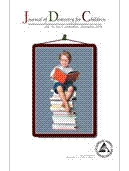
Prevalence of Bruxism and Associated Correlates in Children as Reported by Parents
Purpose: The purpose of this study was to determine the prevalence of childhood bruxism and associated correlates, as reported by parents.
Methods: A cross-sectional survey of parents was conducted at 4 private pediatric dental offices and the Children's Hospital Boston Dental Clinic. Data were gathered via a self-administered questionnaire offered to the parents of children under age 17. Factors were evaluated for association with bruxism using chi-square tests and multivariate logistic regression.
Results: Based on 854 surveys analyzed, the children's mean age was 8.1 years and 52% were female. Caucasians represented 87% of the population, and 90% of the parents had attained a high school diploma. The overall prevalence of reported bruxism was 38%. Five percent of the parents reported that their children had subjective symptoms of temporomandibular disorder (TMD); however, these were not associated with reported bruxism. A child with a psychological disorder had a 3.6 times greater likelihood of bruxism. If either parent had a history of bruxism, their child was 1.8 times more likely to brux. If bedroom doors were open, parents reported bruxism 1.7 times more often. Children who drooled at night were 1.7 times more likely to brux, while sleeptalking children were 1.6 times more likely to brux.
Conclusions: (1) Of the 38% of parents reporting that their children brux, familial history, open bedroom doors, drooling, sleeptalking, and psychological disorders were significantly associated with the reported bruxism. (2) While 5% of parents reported that their children had at least one TMD symptom, no TMD symptoms were associated with reported bruxism.
Methods: A cross-sectional survey of parents was conducted at 4 private pediatric dental offices and the Children's Hospital Boston Dental Clinic. Data were gathered via a self-administered questionnaire offered to the parents of children under age 17. Factors were evaluated for association with bruxism using chi-square tests and multivariate logistic regression.
Results: Based on 854 surveys analyzed, the children's mean age was 8.1 years and 52% were female. Caucasians represented 87% of the population, and 90% of the parents had attained a high school diploma. The overall prevalence of reported bruxism was 38%. Five percent of the parents reported that their children had subjective symptoms of temporomandibular disorder (TMD); however, these were not associated with reported bruxism. A child with a psychological disorder had a 3.6 times greater likelihood of bruxism. If either parent had a history of bruxism, their child was 1.8 times more likely to brux. If bedroom doors were open, parents reported bruxism 1.7 times more often. Children who drooled at night were 1.7 times more likely to brux, while sleeptalking children were 1.6 times more likely to brux.
Conclusions: (1) Of the 38% of parents reporting that their children brux, familial history, open bedroom doors, drooling, sleeptalking, and psychological disorders were significantly associated with the reported bruxism. (2) While 5% of parents reported that their children had at least one TMD symptom, no TMD symptoms were associated with reported bruxism.
Keywords: BRUXISM; CHILDREN; TEMPOROMANDIBULAR DISORDER
Document Type: Research Article
Publication date: 01 May 2005
- Acquired after the merger between the American Society of Dentistry for Children and the American Academy of Pediatric Dentistry in 2002, the Journal of Dentistry for Children (JDC) is an internationally renowned journal whose publishing dates back to 1934. Published three times a year, JDC promotes the practice, education and research specifically related to the specialty of pediatric dentistry. It covers a wide range of topics related to the clinical care of children, from clinical techniques of daily importance to the practitioner, to studies on child behavior and growth and development. JDC also provides information on the physical, psychological and emotional conditions of children as they relate to and affect their dental health.
- Information for Authors
- Submit a Paper
- Subscribe to this Title
- Membership Information
- Information for Advertisers
- Ingenta Connect is not responsible for the content or availability of external websites
- Access Key
- Free content
- Partial Free content
- New content
- Open access content
- Partial Open access content
- Subscribed content
- Partial Subscribed content
- Free trial content